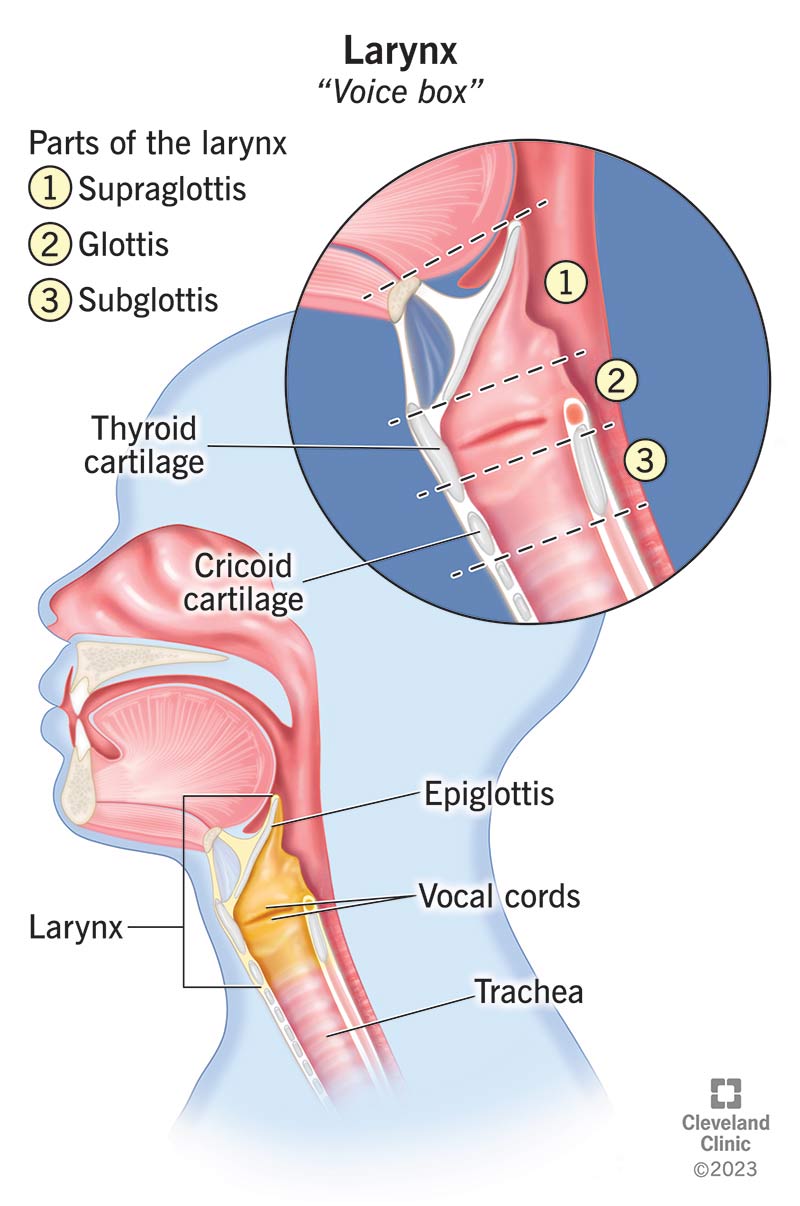Your larynx is a hollow tube in the middle of your neck, just above your trachea (windpipe) and esophagus. It makes it possible for you to make sounds, which is why it’s also called your voice box. It also lets air pass from your throat to your trachea and on to your lungs.
Advertisement
Cleveland Clinic is a non-profit academic medical center. Advertising on our site helps support our mission. We do not endorse non-Cleveland Clinic products or services. Policy

Your larynx is part of your respiratory system. It’s a hollow tube that’s about 4 to 5 centimeters (cm) in length and width. It lets air pass from your throat (pharynx) to your trachea on the way to your lungs. Your larynx is also the reason you’re able to make sounds, so it’s often called your voice box.
Advertisement
Cleveland Clinic is a non-profit academic medical center. Advertising on our site helps support our mission. We do not endorse non-Cleveland Clinic products or services. Policy
Your larynx helps you to:
Your larynx is in the middle of your neck, just above your trachea (windpipe) and your esophagus. But its exact location changes throughout your life.
From birth up until age 2, your larynx was higher in your neck. Over time, your larynx moves down to the middle of your neck.
Your larynx is divided into three parts:
Your supraglottis, glottis and subglottis have different types of cartilage, muscle, ligaments and membranes, but only your glottis contains your vocal folds (vocal cords):
Many things can affect your larynx, from diseases like cancer to simply using your voice too much. Conditions that affect your larynx include:
Advertisement
Some common symptoms are:
Talk to your healthcare provider if you’ve had these symptoms for more than two weeks.
Tests will vary depending on the suspected cause, but may include:
Acute and chronic laryngitis
Laryngeal cancer
Vocal cord dysfunction
Treatment depends on your situation but could include:
Vocal cord lesions
Treatment depends on the underlying cause but may include:
Vocal cord paralysis
There are lots of ways to take care of your larynx and your voice, including:
Advertisement
Several conditions can affect your larynx. You should contact your provider if you have symptoms that don’t go away after treatment or get worse.
They can, but they’d have to learn new ways to speak and communicate. For example, some people who have surgery to remove their larynx may use an electrolarynx. An electrolarynx is an artificial larynx that you hold against your throat to make your speech clearer.
Your larynx is a hardworking part of your respiratory system. You have a healthy larynx to thank anytime you make sounds, from speaking up to singing and shouting. Likewise, your larynx helps you to breathe and keeps food and drink from getting into your lungs. You can keep your larynx healthy by avoiding activities that increase your risk of infections, laryngeal cancer or strained vocal cords.
Advertisement
You don’t have to live with voice box problems. Cleveland Clinic has the larynx disorder treatments you need.

Last reviewed on 08/23/2023.
Learn more about the Health Library and our editorial process.